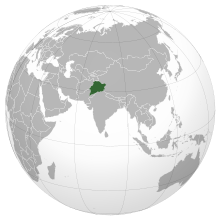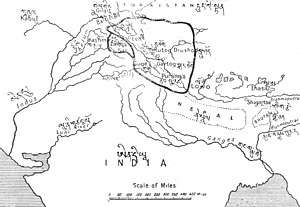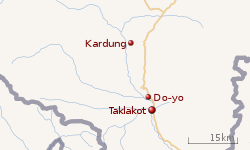Dogra–Tibetan War
The Dogra–Tibetan War[1][2] or Sino-Sikh War[3] was fought from May 1841 to August 1842, between the forces of the Dogra nobleman Gulab Singh of Jammu, under the suzerainty of the Sikh Empire, and Tibet under the suzerainty of Qing China.[2] Gulab Singh's commander was the able general Zorawar Singh Kahluria, who, after the conquest of Ladakh, attempted to extend its boundaries in order to control the trade routes into Ladakh.[4] Zorawar Singh's campaign, suffering from the effects of inclement weather, suffered a defeat at Minsar (or Missar) and Singh was killed.[5] The Tibetans then advanced on Ladakh. Gulab Singh sent reinforcements under the command of his nephew Jawahir Singh. A subsequent battle near Leh in 1842 led to a Tibetan defeat. The Treaty of Chushul was signed in 1842 maintaining the status quo ante bellum.[6]
| Dogra–Tibetan War | |||||||||
|---|---|---|---|---|---|---|---|---|---|
General Zorawar Singh | |||||||||
| |||||||||
| Belligerents | |||||||||
|
Tibetans, under the suzerainty of |
Jammu, under the suzerainty of the | ||||||||
| Commanders and leaders | |||||||||
|
Meng Bao Haipu |
| ||||||||
| Strength | |||||||||
| 5,000 | 10,000 | ||||||||
| Dogra–Tibetan War | |||||||
|---|---|---|---|---|---|---|---|
| Traditional Chinese | 森巴戰爭 | ||||||
| Simplified Chinese | 森巴战争 | ||||||
| Literal meaning | Dogra War | ||||||
| |||||||
Background
Ladakh trade
In the 19th century, Ladakh was the hub of trade routes that branched out into Turkestan and Tibet. Its trade with Tibet was governed by the 1684 Treaty of Tingmosgang, by which Ladakh had the exclusive right to receive the pashmina wool produced in Tibet, in exchange for brick-tea.[7][8] The world-renowned Kashmir shawl industry received its pashm wool supplies from Ladakh.[9]
Political environment

In the early 1800s, the Kashmir Valley and the adjoining Jammu area were part of the Sikh Empire. But the Dogras of Jammu were virtually autonomous under the rule of Raja Gulab Singh, who was positioning himself to take control of Kashmir and all the surrounding areas after the passing of Sikh monarch Ranjit Singh.[10] In 1834, Gulab Singh sent his ablest general Zorawar Singh to take control of all the territory between Jammu and the Tibet border.[11] By 1840, Ladakh and Baltistan were firmly under Dogra control, subject to the suzerainty of the Sikh Empire.[12]
The British East India Company was the predominant power in the Indian subcontinent. It tolerated the Sikh Empire as a valuable ally against the Afghans, but it also had designs for its own pashmina trade with Tibet. Zorawar Singh's conquest of Ladakh broke the Kashmiri–Ladakhi monopoly on Tibet trade, and the Tibetan pashmina wool started finding its way into British territory. To regain the monopoly, Gulab Singh and Zorawar Singh turned their eyes towards Tibet.[13][14]
From the early 18th century, the Manchu-led Qing dynasty had consolidated its control of Tibet after defeating the Dzungar Khanate. From then until late into the 19th century, the Qing rule of the region remained unchallenged.
Invasion of Tibet
 |
Zorawar Singh led a 4,000 men-strong force consisting of Ladakhis, Baltis and Kishtwaris with a Dogra core.[4] The Tibetan estimate was 6,000 men. They were armed with guns and cannon whereas the Tibetans were mostly armed with bows, swords and spears.[15]
Zoarawar Singh divided his forces into three divisions, sending one via the Rupshu valley via Hanle, one along the Indus valley towards Tashigang (Zhaxigang) and another along the Pangong lake towards Rudok (Rutog). The first two contingents plundered the Buddhist monasteries at Hanle and Tashigang.[note 1] The third division, commanded by Zorawar Singh, captured Rudok and then moved south, joining the other branches to attack Gartok.[17][15]
The Tibetan border officials had, by then, sent an alert to Lhasa.[18] The Tibetan government dispatched a force under the command of cabinet minister Pellhün.[19] Meanwhile, Zorawar Singh had captured Gartok as well as Taklakot (Burang) near Nepal border. The Tibetan general was unable to hold Taklakot and retreated to the Mayum La, the border of West Tibet.[20]
Zorawar Singh invoked the historical claims of Ladakh to western Tibet up to the Mayum Pass (originally called Maryul of Ngari),[21] which were presumably exercised prior to the 1648 Treaty of Tingmosgang. All the captured forts were garrisoned, while the main force was encamped at Tirthapuri to the west of Lake Manasarovar.[22] Administration was set up to rule the occupied territories.[23] Minsar (or Missar, now called Menshixiang), which was a Ladakhi enclave by the 1648 Treaty,[24] was used to store supplies.[25]

The Chinese Amban at Lhasa reported to the emperor on 2 September 1841:
It has been learned that south of Ladakh there is a very large aboriginal tribe named Ren-chi-shen [Ranjit Singh]. Subordinate to this tribe are two smaller tribes-- Sa-re-shen [Sher Singh] and Ko-lang-shen [Gulab Singh], who together are known as the Shen-pa ["Singh people", possibly referring Sikhs and Dogra Rajputs together]. After the death of the Ladakhi ruler [Tshe-pal Nam-gyal], a certain Ladakhi chieftain had secret connections with the Shen-pa, who then occupied Ladakh. Now this Ladakhi chieftain is once again in league with the Shen-pa aborigines who have invaded Tibetan territory, occupied two of our military posts at Gartok and Rudok, and claimed the territory west of the Mayum that had formerly belonged to Ladakh. Actually they intended to occupy more territory than this.[26]
British and Nepalese reactions
The Dogra conquest of Ladakh had been previously advantageous to the British. The disturbances in Ladakh caused the Tibetan shawl wool to be diverted to the princely state of Bushahr, a British dependency. But, now with the Dogra conquest of west Tibet, this trade was disrupted.[20][27] The advance of Zorawar Singh's troops gave rise to vociferous complaints from the British to the Lahore durbar of the Sikh Empire. It was also reported that Zorawar Singh was exacting taxes from Bhotias under British potection in the Byans valley. The British demanded that this should be immediately stopped and the villagers already assessed should be compensated.[28]
Added to these concerns was the possibility of intercourse between the Dogras and the Nepalese, with might have encircled British territory in Kumaon and Garhwal.[20][29] But such a relationship did not materialise. The Nepalese were sympathetic to the Ladakhis and they also had ongoing relationships with the Tibetans. Even though they sent a mission to Zorawar Singh after his conquest of Taklakot, nothing came of it. Winter sojourn to the Dogras was refused.[30]
Nevertheless, the British were apprehensive. The Governor General brought heavy pressure on the Sikhs to recall Zorawar Singh from Tibet, and set 10 December 1841 as the deadline.[30]
Winter debacle
Fisher et al. state that, with the winter approaching, the Dogras were not inimical to withdrawing in strength if they could make a deal with the Tibetans. But they appear to have made too high demands for the Tibetans to accept.[22] Sukhdev Singh Charak states that the Lahore Durbar responded to the Brisith demands and ordered Zorawar Singh to return to Ladakh. In response, Zorawar Singh withdrew officers and troops from "advance posts" and from the British border, and promised to carry out the rest of the withdrawal after the snows cleared. Charak opines that these military movements, made to appease the British, weakened Zorawar Singh's position.[31]
Tibetan reinforcements arrived in November in considerable numbers. Alexander Cunningham estimated 10,000 troops.[32][note 2] The Mayum Pass was covered with snow, but the troops bypassed it via Matsang. After severe fighting, Taklakot was retaken on 9 November 1941. Detachments were sent forward to cut Dogra communication lines. Reconnaissance missions sent by Zorawar Singh were annihilated.[22][33]
Eventually, Zorawar Singh decided to risk everything in an all-out campaign to recapture Taklakot. Fighting raged indecisively for three weeks.[22] In an attempt to cut the supply lines of the Tibetan forces at Taklakot, Zorawar Singh's forces marched on a side route from Minsar, along the upper course of the Ghaghara River, and encamped at Kardung (Kardam). Tibetans calculated that they intended to intercept the supply line at a place called Do-yo slightly to the north of Taklakot.[16] According to the Tibetan report from the battlefield:
 |
During this period, there was a great snowstorm and snow accumulated to the depth of several feet. A well-disguised ambush was carefully laid, in which a road was left open through the middle of our lines up which the enemy could advance. The invaders marched on Do-yo from 7 A.M. to 9 A.M. on the second day, 11th month [14 December 1841]. These forces included the troops stationed at their new fort at Chi-t'ang in addition to the force led by the Wazir [Zorawar Singh], the Shen-pa commander. They advanced in three units with flags flying and drums beating. General Pi-hsi led his troops to resist their advance. The invaders fell into the ambush that had been prepared and their rearguard was cut off and could not maneuver. They were attacked by our forces from all sides.[24]
Zorawar Singh was wounded in the battle, but he continued to fight with a sword. He was beheaded by Tibetan soldiers.[24] Three hundred of the Dogra troops were killed in combat and about seven hundred were captured. The rest fled to Ladakh. The Tibetans pursued them up to Dumra (Nubra Valley,[34] possibly Diskit), a day's journey from Leh, where they encamped.[35]
Tibetan invasion of Ladakh
The Sino-Tibetan force then mopped up the other garrisons of the Dogras and advanced on Ladakh, now determined to conquer it and add it to the Imperial Chinese dominions. However the force under Mehta Basti Ram withstood a siege for several weeks at Chi-T’ang before escaping with 240 men across the Himalayas to the British post of Almora. Within Ladakh the Sino-Tibetan army laid siege to Leh, when reinforcements under Diwan Hari Chand and Wazir Ratnu arrived from Jammu and repulsed them. The Tibetan fortifications at Drangtse were flooded when the Dogras dammed up the river. On open ground, the Chinese and Tibetans were chased to Chushul. The climactic Battle of Chushul (August 1842) was won by the Dogras who killed the Tibetan army's general to avenge the death of Zorawar Singh.[36][37]
Treaty of Chushul
At this point, neither side wished to continue the conflict, as the Sikhs were embroiled in tensions with the British that would lead up to the First Anglo-Sikh War, while the Qing were in the midst of the First Opium War with the East India Company. Qing China and the Sikh Empire signed a treaty in September 1842 that stipulated no transgressions or interference in the other country's frontiers.[38]
As on this auspicious day, the 3nd of Assuj, samvat 1899 (16th/17th September 1842) we, the officers of the Lhasa (Governrnent), Kalon of Sokan and Bakshi Shajpuh, commander of the forces, and two officers on behalf of the most resplendent Sri Khalsa ji Sahib, the asylum of the world, King Sher Singh ji, and Sri Maharaja Sahib Raja-i-Rajagan Raja Sahib Bahadur Raja Gulab Singh, i.e.. the Muktar-ud-Daula Diwan Hari Chand and the asylum of vizirs, Vizir Ratnun. in a meeting called together for the promotion of peace and unity, and by professions and vows of friendship, unity and sincerity of heart and by taking oaths like those of Kunjak Sahib, have arranged and agreed that relations of peace, friendship and unity between Sri Khalsaji and Sri Maharaja Sahib Bahadur Raja Gulab Singh ji, and the Emperor of China and the Lama Guru of Lhasa will hence forward remain firmly established forever; and we declare in the presence of the Kunjak Sahib that on no account whatsoever will there be any deviation, difference of departure (from this agreement). We shall neither at present nor in the future have anything to do or interfere at all with the boundaries of Ladakh and its surroundings as fixed from ancient times and will allow the annual export of wool, shawls and tea by way of ladakh according to the old established customs. Should any of the Opponents of Sri Sarkar Khalsa ji and Sri Raja Sahib Bahadur at any time enter our territories, we shall not pay any heed to his words or allow him to remain in our country. We shall offer no hindrance to traders of Ladakh who visit our territories. We shall not even to the extent of a hair's breadth act in contravention of the terms that we have agreed to above regarding firm friendship, unity, the fixed boundaries of Ladakh and the keeping open of the route for wool, shawls and tea. We call Kunjak Sahib, Kairi, Lassi, Zhon Mahan, and Khushal Chon as witnesses to this treaty.[38]
Notes
- According to Cunningham, the commander responsible for the destruction of monasteries was Ghulam Khan, the son-in-law of Rahim Khan. After his capture by the Tibetans, he was tortured to death.[16]
- Sources state that Zorawar Singh had 3,000 troops at this stage. So he was outnumbered 3 to 1.
References
Citations
- Sarees & Wayman, Resort to War (2010), p. 504.
- Fisher, Rose & Huttenback, Himalayan Battleground (1963), pp. 49–59.
- Guo, Rongxing (2015). China’s Regional Development and Tibet. Springer. p. 5. ISBN 978-981-287-958-5.
- Fisher, Rose & Huttenback, Himalayan Battleground (1963), p. 49.
- Huttenback, Gulab Singh (1961), p. 485.
- Huttenback, Gulab Singh (1961), p. 487.
- Warikoo, India's gateway to Central Asia (2009), p. 4: "Tibet’s trade with Ladakh and Kashmir was regulated by the Treaty of Tingmosgang, concluded in 1684, under which Ladakh got the monopoly over shawl-wool produced in Tibet, and the Tibetans acquired the exclusive right to the brick-tea trade with Ladakh."
- Mehra, An "agreed" frontier (1992), p. 71: "The pashmina goat is indigenous to Ladakh, western Tibet and parts of the Tien Shan mountains where a harsh but snow-less winter and availability of grass for fodder through the year produces the finest pashm. "
- Warikoo, India's gateway to Central Asia (2009), p. 2.
- Huttenback, Gulab Singh (1961), p. 479.
- Huttenback, Gulab Singh (1961), p. 480.
- Huttenback, Gulab Singh (1961), pp. 480–482.
- Huttenback, Gulab Singh (1961), pp. 480–482: "Gulab Singh had consolidated his position in Ladakh; still he was not satisfied. Knowing the advantages of controlling the profitable wool trade, he was not content to allow the major benefits to devolve to the British. ... All that was needed to possess the entire wool trade was the acquisition of the very territories where the goats were raised—the Chang Thung Plains of Western Tibet."
- Sarees & Wayman, Resort to War (2010), p. 504: "In 1840 a disruption of the wool and tea trade had caused economic harm to Jammu. An alternative trade route had been developed as a result of a British endeavor to export opium through Tibet. Thus the Dogra concluded that a solution would be to capture western Tibet, thereby disrupting the newer route."
- Shakabpa, One Hundred Thousand Moons (2010), p. 583.
- Fisher, Rose & Huttenback, Himalayan Battleground (1963), p. 164.
- Fisher, Rose & Huttenback, Himalayan Battleground (1963), pp. 49–50.
- Fisher, Rose & Huttenback, Himalayan Battleground (1963), pp. 49-50.
- Shakabpa, One Hundred Thousand Moons (2010), pp. 583–584.
- Fisher, Rose & Huttenback, Himalayan Battleground (1963), p. 50.
- Fisher, Rose & Huttenback, Himalayan Battleground (1963), p. 50: "Zorawar Singh then announced his intention to conquer in the name of the Jammu Raja all of Tibet west of the Mayum Pass, on the ground that this territory had rightfully belonged, since ancient times, to the ruler of Ladakh."
- Fisher, Rose & Huttenback, Himalayan Battleground (1963), p. 53.
- McKay, History of Tibet (2003), p. 28
- Fisher, Rose & Huttenback, Himalayan Battleground (1963), p. 165
- Fisher, Rose & Huttenback, Himalayan Battleground (1963), p. 190.
- Fisher, Rose & Huttenback, Himalayan Battleground (1963), p. 158.
- Huttenback, Gulab Singh (1961), p. 482.
- Huttenback, Gulab Singh (1961), pp. 482–484.
- Huttenback, Gulab Singh (1961), p. 484.
- Fisher, Rose & Huttenback, Himalayan Battleground (1963), p. 51.
- Charak, General Zorawar Singh (2003), p. 758.
- Charak, General Zorawar Singh (2003), p. 761 and note 33 (p. 766).
- Charak, General Zorawar Singh (2003), p. 759.
- Kapadia, Harish (1999). Across Peaks & Passes in Ladakh, Zanskar & East Karakoram. Indus Publishing. p. 230. ISBN 978-81-7387-100-9.
- Shakabpa, One Hundred Thousand Moons (2010), pp. 576–577, 583–584.
- Sino-Dogra War, Histomil.com, 6 February 2012
- Sandhya Jain (21 May 2013). "On the defensive on too many occasions". The Pioneer.
- Rubin, Alfred P. (1960), "The Sino-Indian Border Disputes", International and Comparative Law Quarterly, 9 (1): 96–124, doi:10.1093/iclqaj/9.1.96, JSTOR 756256
Sources
- Bakshi, G. D. (2002), Footprints in the snow: on the trail of Zorawar Singh, Lancer Publishers, ISBN 9788170622925
- Fisher, Margaret W.; Rose, Leo E.; Huttenback, Robert A. (1963), Himalayan Battleground: Sino-Indian Rivalry in Ladakh, Praeger – via Questia
- Heath, Ian (2005), The Sikh Army 1799–1849, Osprey Publishing, ISBN 1-84176-777-8
- Huttenback, Robert A. (1961), "Gulab Singh and the Creation of the Dogra State of Jammu, Kashmir, and Ladakh" (PDF), The Journal of Asian Studies, 20 (4): 477–488, doi:10.2307/2049956
- Shakabpa, W. D. (2010), One Hundred Thousand Moons: An Advanced Political History of Tibet, 1, translated by Derek F. Maher, BRILL, ISBN 9789004177888
- McKay, Alex (2003), History of Tibet, Volume 2: The Medieval Period: c. 850–1895, Routledge, ISBN 0-415-30843-7
- Charak, Sukhdev Singh (2003), "General Zora War Singh (extracts)", in McKay, Alex (ed.), History of Tibet, Volume 2: The Medieval Period: c. 850–1895, Routledge, pp. 748–767, ISBN 0-415-30843-7
- Mehra, Parshotam (1992), An "agreed" frontier: Ladakh and India's northernmost borders, 1846–1947, Oxford University Press
- Sarkees, Meredith Reid; Wayman, Frank Whelon (2010), Resort to War: A data guide to inter-state, extra-state, intra-state, and non-state wars, 1816-2007, CQ Press, ISBN 978-0-87289-434-1
- Warikoo, K. (2009), "India's gateway to Central Asia: trans-Himalayan trade and cultural movements through Kashmir and Ladakh, 1846–1947", in Warikoo, K. (ed.), Himalayan Frontiers of India: Historical, Geo-Political and Strategic Perspectives, Routledge, ISBN 978-1-134-03294-5